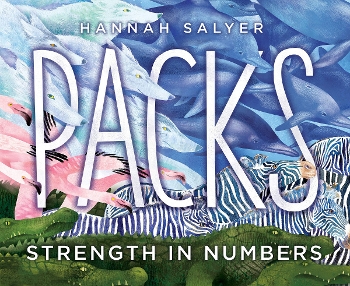Hannah Salyer may not be a name you know, but her book, Packs: Strength in Numbers, is a rarity. It’s a debut picture book by a young and talented illustrator receiving award buzz. A select few first-time illustrators have won Caldecott recognition. Could Salyer’s name be added to this stellar list? Her exquisite page layouts, expert use of color, and gestural lines that emulate texture and movement will give the committee much to discuss.
 Hannah Salyer may not be a name you know, but her book, Packs: Strength in Numbers, is a rarity. It’s a debut picture book by a young and talented illustrator receiving award buzz. She has already been featured in interviews at Seven Impossible Things Before Breakfast and Kirkus. With fluid lines created in paint and cut paper and finished digitally, her work feels like a Steve Jenkins book with a looser hand. A select few first-time illustrators have won Caldecott recognition, including Erin Stead, Ekua Holmes, Juana Martinez-Neal, Oge Mora, Thi Bui, and Aaron Becker. Could Salyer’s name be added to this stellar list? Her exquisite page layouts, expert use of color, and gestural lines that emulate texture and movement will give the committee much to discuss.
Hannah Salyer may not be a name you know, but her book, Packs: Strength in Numbers, is a rarity. It’s a debut picture book by a young and talented illustrator receiving award buzz. She has already been featured in interviews at Seven Impossible Things Before Breakfast and Kirkus. With fluid lines created in paint and cut paper and finished digitally, her work feels like a Steve Jenkins book with a looser hand. A select few first-time illustrators have won Caldecott recognition, including Erin Stead, Ekua Holmes, Juana Martinez-Neal, Oge Mora, Thi Bui, and Aaron Becker. Could Salyer’s name be added to this stellar list? Her exquisite page layouts, expert use of color, and gestural lines that emulate texture and movement will give the committee much to discuss.
The opening full-bleed, double-page spreads present packs, herds, and huddles of animal groupings and capture the movement and energy as if they were organisms all their own. Readers can feel the speed of white-gray wolves as they dash through a winter landscape and between barren birch trees. A large pod of blue dolphins undulates in a blue ocean, punctuated by bubbles. The roost of flapping monarch butterflies shimmers with yellows, oranges, and umbers and gauzy black outlines. Salyer does a brilliant job of layering each page, likely through cut paper and digital finishing, offering heightened perspectives, from a rust-red and yellow coral colony to a bright pink flamboyance of flamingos, a tangle of legs and necks.
Color also plays a significant role in each animal clan. While many of the packs are presented almost monochromatically, Salyer does an excellent job of distinguishing each animal in the midst of what looks like, at first glance, chaos. The lion pride is almost entirely yellow, but the variety of yellows here is stunning, from ochre to straw to brass, helping distinguish one lion from another. All of this dabbled richness echoes the tawny golds of sub-Saharan Africa, even though the landscape is barely visible on the page. The mob of mongooses is a huddle of midnight blue, but the subtle black stripes and dashes of white of eyes and white claws offer ominous accents and individually delineate creatures within the mob.
Caldecott committee members are looking for books with a strong visual vocabulary, offering an expertly crafted “collective unity” (to quote the Award manual). This is often something that may prove difficult for a new illustrator, but Salyer’s work feels clear and bold. And it is all in service to the book’s theme: how animal packs protect and camouflage themselves. The dizzying black and white of the dazzle of zebras (yes, that is their collective noun) emulates how the stripes confuse predators. The American bison double-page spread shows the power of the herd as it travels, with the young calf well protected in the middle.
[Read the Horn Book Magazine review of Packs here]
On my first reading, I was a bit surprised by the interjection of short paragraphs several pages into the book and Salyer's switch to half-page illustrations with spot art images of solo animals in deep blue. After further reflection and reading, I find it serves as a visual palate cleanser, offering the reader an opportunity to focus on smaller animal clusters, like ants and bees. The lone animal, almost in silhouette, lets the young reader identify the creature up-close and beyond their cluster.
And don’t forget that the text is also a visual element in any picture book. The repeated word “Together…” offers a unifying visual, as well as a rallying cry when read aloud. Short paragraphs delineating the surprising practices of a few of the species are written in a deep blue that matches the single animal illustrations in blue. Whether this choice was Salyer’s or the design team's we may not know, but it demonstrates astute crafting.
Salyer subverts expectations throughout the book. A school of goldsaddle goatfish hunts down smaller prey; Mexican free-tailed bats are a boisterous cloud; spring peeper frogs are a noisy army. And human packs are no different than our animal kin. The double-spread before the back matter shows a diverse group of people engaged in a variety of activities in small groupings, making up a very large human pack. This image may be a bit jarring in 2020 (there is no social distancing here), but it is a visceral reminder that our preferred state is together, rather than apart.
The committee will explore every inch of the book, so don’t forget to look under the dust jacket at the front and back of the case. Here you will see a second cover featuring at least one of the animals featured in the book orbiting the globe. Is this a reminder that we are truly part of the same pack on our small blue-green planet, interdependent upon one another for our own survival? The messaging here is profound, but never heavy-handed.
So gather your pack (maybe over Zoom) to discuss this gem! If you are selecting books to feature at Mock Caldecott programs for children or grown-ups, don’t forget to include a less-than-established author on your shortlist each year. Salyer would be a perfect addition for 2020.
So what’s your take? Will Salyer break out from the pack and take home a Caldecott Medal or Honor?

ALREADY A SUBSCRIBER? LOG IN
We are currently offering this content for free. Sign up now to activate your personal profile, where you can save articles for future viewing.








Add Comment :-
Comment Policy:
Comment should not be empty !!!
Julie Danielson
It really is a remarkable debut. I love the use of vivid colors, balanced by those occasional monochromatic images. The drawings are exquisite, but it's also a practical rest for one's eyes!Posted : Oct 04, 2020 04:45
Rosanne Parry
I really loved this one too. It takes a great science concept and then elevates it beyond that without leaving useful information behind. I'm going to be recommending this one to teachers at the bookshop for years to come.Posted : Oct 03, 2020 04:39
Allison Khoury
Fantastic review - so visual and descriptive. I haven't seen this book in person yet, but feel Iike I've had my first read through with you. Thanks.
Posted : Sep 28, 2020 05:16